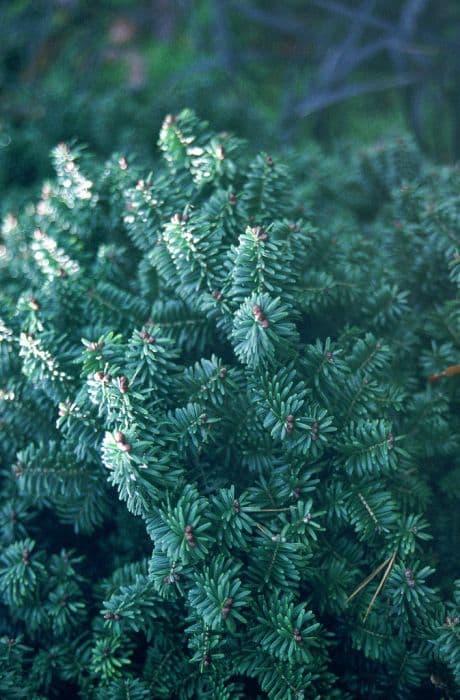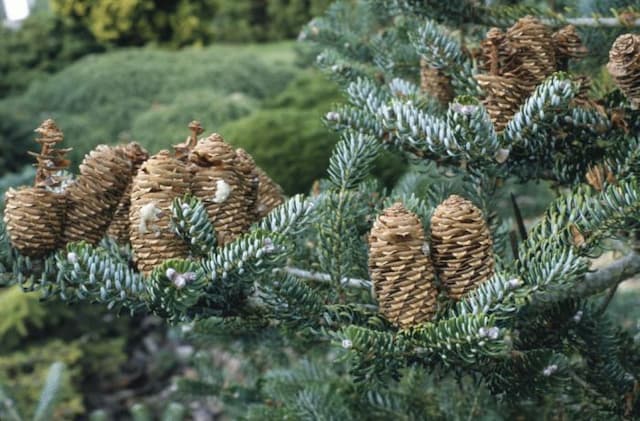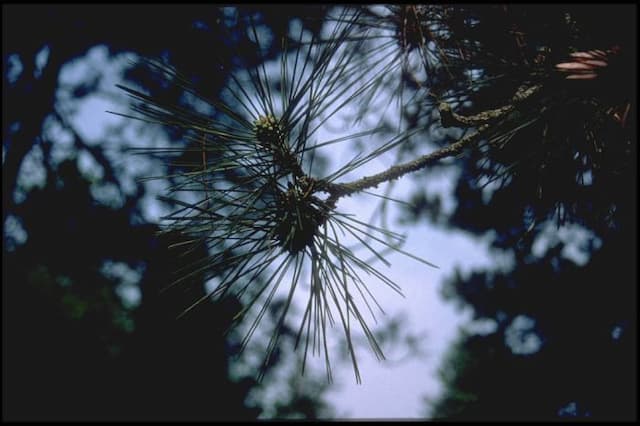Scots Pine Pinus sylvestris

ABOUT
The plant, commonly known as Scots pine, has a distinct and rugged appearance, often characterized by its deeply furrowed, reddish-brown bark that becomes flaky at the top. Its needles are bluish-green, long, and frequently appear in pairs, making a V-shape when observed from the end. These needles can offer a slightly twisted or curved look and have a sharp, pointed tip. This coniferous tree is also notable for its cones, which are oval in shape, often with a slightly curved scale, and take on a woody texture as they mature. The branches of the Scots pine are robust and grow in a spread out pattern, making the tree's silhouette irregular and wide-spreading, contributing to its distinctive and natural aesthetic appeal. As it grows, the plant takes on a more columnar form, and the crown develops into a rounded shape that is recognizable from a distance. The overall form and appearance are influenced by the climate and growing conditions, leading to a variety in its looks across different regions.
About this plant
 Names
NamesFamily
Pinaceae.
Synonyms
Scots Pine, Scotch Pine, Baltic Pine, Norway Pine.
Common names
Pinus sylvestris var. mongolica, Pinus sylvestris var. hamata, Pinus sylvestris var. neilreichii, Pinus sylvestris var. sylvestris, Pinus sylvestris var. scotica, Pinus rubra, Pinus montana, Pinus rubra var. australis, Pinus sylvestris subsp. sylvestris.
 Toxicity
ToxicityTo humans
Pinus sylvestris, commonly known as Scots pine, is generally not considered highly toxic to humans. Ingesting parts of this plant might cause mild gastrointestinal symptoms if ingested in large amounts due to the presence of plant resins and oils. However, incidents of such poisoning are rare and usually not severe. It is still advisable to avoid consuming any part of this plant as a precaution.
To pets
Scots pine is not widely recognized as a poisonous plant to pets. Similar to humans, ingestion of large quantities of pine needles can potentially cause mild gastrointestinal upset such as vomiting or diarrhea in pets due to the presence of resins and oils. It is generally recommended to prevent pets from consuming the plant to avoid any potential discomfort.
 Characteristics
CharacteristicsLife cycle
Perennials
Foliage type
Evergreen
Color of leaves
Green
Height
40 feet (12 meters)
Spread
20 feet (6 meters)
Plant type
Tree
Hardiness zones
2
Native area
Eurasia
Benefits
 General Benefits
General Benefits- Lumber Source: Pinus sylvestris, commonly known as Scots pine, is extensively harvested for timber that is widely used in construction, furniture, and woodworking due to its strength and versatility.
- Paper Production: The wood pulp of Scots pine is utilized in paper manufacturing, including newsprint, packing, and high-quality coated papers.
- Landscaping: Scots pine is a popular choice for landscaping because of its distinctive shape, evergreen foliage, and ability to adapt to a range of soil types and climates.
- Erosion Control: Its robust root system stabilizes soil, making it an excellent species for controlling erosion and rehabilitating disturbed soils.
- Habitat Provision: Scots pine forests support a diverse ecosystem, providing habitat and food sources for various wildlife species, including birds, squirrels, and insects.
- Ornamental Use: Often used as a Christmas tree due to its symmetrical form and attractive needle foliage.
- Shade and Shelter: The tree provides shade and windbreaks which can protect crops, livestock, and buildings from harsh weather conditions.
- Reforestation: Scots pine is used in reforestation projects, especially in degraded areas, as it grows relatively fast and is resilient to poor conditions.
 Medical Properties
Medical Properties- Antiseptic: Pinus sylvestris, commonly known as Scots pine, has been used for its antiseptic properties, often in the form of essential oil derived from its needles and twigs.
- Anti-inflammatory: The essential oil of Scots pine may possess anti-inflammatory properties that could be beneficial in reducing inflammation.
- Expectorant: Historically, Scots pine has been used to help clear mucus from the respiratory tract.
- Aromatherapy: The scent of Scots pine oil is used in aromatherapy to help reduce stress and invigorate the senses.
- Muscular Pain Relief: Its essential oil, when diluted and applied topically, has been used to help relieve muscular aches and pains.
- Respiratory Health: Inhalation of Scots pine essential oil has been associated with supporting respiratory health.
- Wound Healing: Extracts from Scots pine have been suggested to help in healing minor wounds or cuts, owing to their potential antiseptic qualities.
 Air-purifying Qualities
Air-purifying QualitiesThis plant is not specifically known for air purifying qualities.
 Other Uses
Other Uses- Scots pine is often used in forest restoration efforts and reforestation projects as it is fast-growing and adaptable to a variety of soil types, making it ideal for stabilizing and improving soil quality.
- This tree's wood is a popular choice for making furniture, flooring, and paneling, appreciated for its pleasant color, patterns, and durability.
- Pinus sylvestris is utilized in the shipbuilding industry, especially for masts and planking, due to its tall, straight growth habit and strong wood.
- The resin of Scots pine is tapped for the production of turpentine, which serves as a solvent in paints and varnishes.
- The long fibers in the tree's wood pulp make it valuable in the paper manufacturing industry, where it is used to produce high-quality paper products.
- The tree is often planted as a decorative tree in parks and large gardens due to its attractive form and foliage.
- It provides habitat and food for wildlife; its seeds are a food source for birds such as crossbills, and the bark can house various insects.
- Scots pine needles can be used to make pine needle tea, which is rich in vitamins and can traditionally be used as a mild beverage.
- The branches and treetops are used in some countries as Christmas trees due to their symmetrical shape and fresh scent.
- In landscaping, the Scots pine's ability to withstand windy conditions makes it suitable for use as a windbreak or for afforestation in coastal and heather landscapes.
Interesting Facts
 Feng Shui
Feng ShuiThe Scots Pine is not used in Feng Shui practice.
 Zodiac Sign Compitability
Zodiac Sign CompitabilityThe Scots Pine is not used in astrology practice.
 Plant Symbolism
Plant Symbolism- Resilience and Longevity: Pinus sylvestris, commonly known as Scots Pine, often symbolizes resilience and longevity due to its ability to thrive in harsh conditions and its long lifespan.
- Wisdom and Foresight: The longevity of Scots Pine can also be associated with wisdom and foresight, embodying the knowledge accumulated over a long life.
- Purity and Cleansing: Scots Pine has been traditionally thought to have purifying qualities, making it symbolic of cleansing and renewal.
- Protection: With its evergreen needles, the Scots Pine is believed to offer protection and to ward off negative influences.
- Health and Vitality: The invigorating scent of Scots Pine is associated with health and vitality, representing robustness and vigor.
 Water
WaterThe Scots Pine, commonly referred to as Pinus sylvestris, prefers a moderate watering regime, being watered when the topsoil feels dry to the touch. During the growing season, which is from spring to fall, water the plant every week or two, ensuring that the soil is moist but not waterlogged, using approximately 1 to 2 gallons per watering for a young tree in a garden setting. During winter, reduce watering to once a month or less, depending on the rainfall and temperatures. Always allow proper drainage to prevent root rot, and never let the tree sit in standing water. Over-watering can be as harmful as under-watering, so it's crucial to adjust your watering frequency based on weather conditions and soil moisture levels.
 Light
LightScots Pine thrives best in full sunlight, meaning it should receive at least 6 to 8 hours of direct sunlight each day. It is best positioned in a spot where it can get unobstructed light from above, making it an ideal tree for open landscapes or yards without tall buildings or dense canopies blocking the sun. These trees are adapted to a wide range of light conditions but perform optimally with abundant sun.
 Temperature
TemperatureThe Scots Pine is adapted to a wide range of temperatures and can survive in temperatures as low as -40 degrees Fahrenheit and as high as 100 degrees Fahrenheit. Nonetheless, the ideal temperature range for this tree is between 60 to 70 degrees Fahrenheit. They are hardy and can endure cold winters, making them suitable for various climates, but they do not tolerate extreme heat well for prolonged periods.
 Pruning
PruningPruning the Scots Pine is generally done to remove dead or diseased branches, shape the tree, or encourage a more robust structure. The best time for pruning is during the late winter to early spring before new growth begins. Typically, this tree requires minimal pruning, and any significant cutting should be performed every 2 to 3 years. Removing lower branches to raise the canopy is common, but refrain from heavy topping or reducing the tree's height as it can damage its natural form.
 Cleaning
CleaningNot needed
 Soil
SoilScotch Pine (Pinus sylvestris) thrives in well-draining, acidic to neutral soil with a pH range of 5.5 to 7.0. A mixture of sand, peat, and loamy soil is ideal to mimic its natural growing conditions. Regular pine bark mulch can also be mixed into the soil to enhance drainage and mimic the forest floor.
 Repotting
RepottingScotch Pine should be repotted every 2 to 3 years to prevent root-bound conditions and to refresh the soil. Juvenile trees may require more frequent repotting, while mature Scotch Pines can be repotted less often as their growth rate slows.
 Humidity & Misting
Humidity & MistingScotch Pine prefers a dry to moderate humidity environment and is quite tolerant of different atmospheric humidity levels, as long as the soil drainage is good and it is not exposed to persistently wet conditions.
 Suitable locations
Suitable locationsIndoor
Provide bright light, cool spot, well-draining soil.
Outdoor
Full sun, well-drained soil, space for growth.
Hardiness zone
3-7 USDA
 Life cycle
Life cycleScots Pine (Pinus sylvestris) begins its life as a seed, typically dispersed by wind due to its winged structure. After landing on a suitable substrate, the seed germinates and develops into a seedling, establishing a root system and a shoot that emerges above the ground. As the plant grows, it enters a phase of rapid growth, maturing into a sapling with a distinguishable pine stem and needle-like leaves. The tree continues to grow for many years, eventually reaching maturity, during which it begins to produce cones—the female cones are woody and contain ovules, while the male cones produce pollen. Pollination occurs mostly through wind, and once fertilized, the female cones develop seeds. The mature Scots Pine can live for hundreds of years, during which it will continue to undergo seasonal cycles of growth, cone production, and seed dispersal.
 Propogation
PropogationPropogation time
Spring to early summer
The Scots pine (Pinus sylvestris), a species revered for its stately presence in landscapes and forests, is commonly propagated using seeds. The best time for seed propagation is typically late winter to early spring. After collection, seeds require a stratification period—a cold treatment that simulates winter conditions. This stratification usually lasts for about 60 to 90 days at 33-41 degrees Fahrenheit (0.5-5 degrees Celsius). Once stratified, seeds are sown in well-draining soil and placed in a location with plenty of light. They should be kept moist until germination, which can take several weeks. As seedlings grow and establish themselves, they are then ready for eventual transplanting into their permanent outdoor locations.









